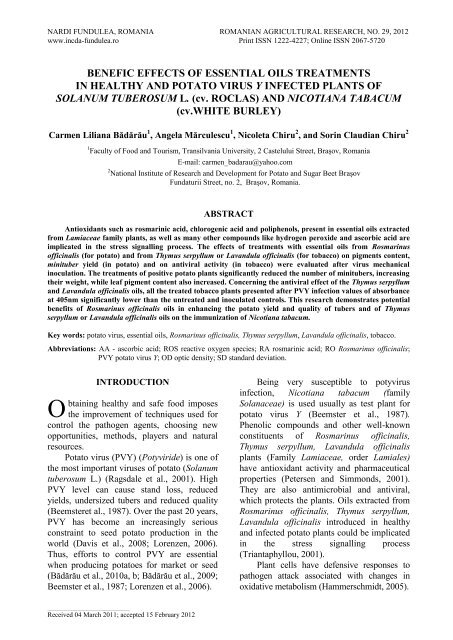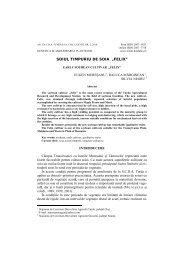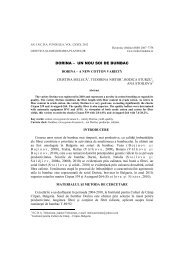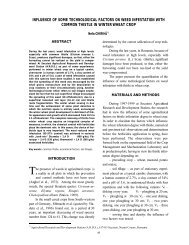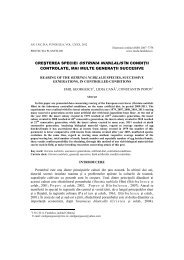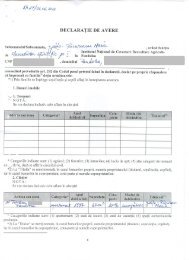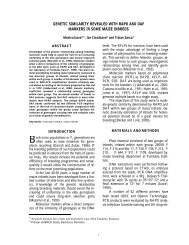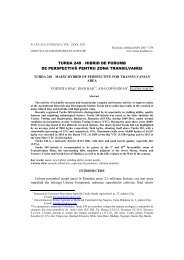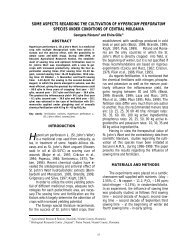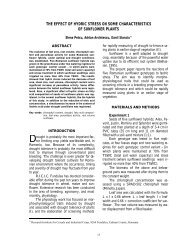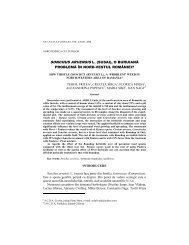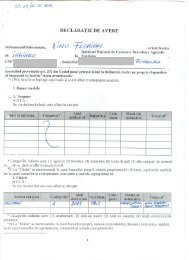Benefic effects of essential oils treatments in
Benefic effects of essential oils treatments in
Benefic effects of essential oils treatments in
Create successful ePaper yourself
Turn your PDF publications into a flip-book with our unique Google optimized e-Paper software.
NARDI FUNDULEA, ROMANIA ROMANIAN AGRICULTURAL RESEARCH, NO. 29, 2012<br />
www.<strong>in</strong>cda-fundulea.ro Pr<strong>in</strong>t ISSN 1222-4227; Onl<strong>in</strong>e ISSN 2067-5720<br />
BENEFIC EFFECTS OF ESSENTIAL OILS TREATMENTS<br />
IN HEALTHY AND POTATO VIRUS Y INFECTED PLANTS OF<br />
SOLANUM TUBEROSUM L. (cv. ROCLAS) AND NICOTIANA TABACUM<br />
(cv.WHITE BURLEY)<br />
Carmen Liliana Bădărău 1 , Angela Mărculescu 1 , Nicoleta Chiru 2 , and Sor<strong>in</strong> Claudian Chiru 2<br />
1 Faculty <strong>of</strong> Food and Tourism, Transilvania University, 2 Castelului Street, Braşov, Romania<br />
E-mail: carmen_badarau@yahoo.com<br />
2 National Institute <strong>of</strong> Research and Development for Potato and Sugar Beet Braşov<br />
Fundaturii Street, no. 2, Braşov, Romania.<br />
ABSTRACT<br />
Antioxidants such as rosmar<strong>in</strong>ic acid, chlorogenic acid and poliphenols, present <strong>in</strong> <strong>essential</strong> <strong>oils</strong> extracted<br />
from Lamiaceae family plants, as well as many other compounds like hydrogen peroxide and ascorbic acid are<br />
implicated <strong>in</strong> the stress signall<strong>in</strong>g process. The <strong>effects</strong> <strong>of</strong> <strong>treatments</strong> with <strong>essential</strong> <strong>oils</strong> from Rosmar<strong>in</strong>us<br />
<strong>of</strong>fic<strong>in</strong>alis (for potato) and from Thymus serpyllum or Lavandula <strong>of</strong>fic<strong>in</strong>alis (for tobacco) on pigments content,<br />
m<strong>in</strong>ituber yield (<strong>in</strong> potato) and on antiviral activity (<strong>in</strong> tobacco) were evaluated after virus mechanical<br />
<strong>in</strong>oculation. The <strong>treatments</strong> <strong>of</strong> positive potato plants significantly reduced the number <strong>of</strong> m<strong>in</strong>itubers, <strong>in</strong>creas<strong>in</strong>g<br />
their weight, while leaf pigment content also <strong>in</strong>creased. Concern<strong>in</strong>g the antiviral effect <strong>of</strong> the Thymus serpyllum<br />
and Lavandula <strong>of</strong>fic<strong>in</strong>alis <strong>oils</strong>, all the treated tobacco plants presented after PVY <strong>in</strong>fection values <strong>of</strong> absorbance<br />
at 405nm significantly lower than the untreated and <strong>in</strong>oculated controls. This research demonstrates potential<br />
benefits <strong>of</strong> Rosmar<strong>in</strong>us <strong>of</strong>fic<strong>in</strong>alis <strong>oils</strong> <strong>in</strong> enhanc<strong>in</strong>g the potato yield and quality <strong>of</strong> tubers and <strong>of</strong> Thymus<br />
serpyllum or Lavandula <strong>of</strong>fic<strong>in</strong>alis <strong>oils</strong> on the immunization <strong>of</strong> Nicotiana tabacum.<br />
Key words: potato virus, <strong>essential</strong> <strong>oils</strong>, Rosmar<strong>in</strong>us <strong>of</strong>fic<strong>in</strong>alis, Thymus serpyllum, Lavandula <strong>of</strong>fic<strong>in</strong>alis, tobacco.<br />
Abbreviations: AA - ascorbic acid; ROS reactive oxygen species; RA rosmar<strong>in</strong>ic acid; RO Rosmar<strong>in</strong>us <strong>of</strong>fic<strong>in</strong>alis;<br />
PVY potato virus Y; OD optic density; SD standard deviation.<br />
O<br />
INTRODUCTION<br />
bta<strong>in</strong><strong>in</strong>g healthy and safe food imposes<br />
the improvement <strong>of</strong> techniques used for<br />
control the pathogen agents, choos<strong>in</strong>g new<br />
opportunities, methods, players and natural<br />
resources.<br />
Potato virus (PVY) (Potyviride) is one <strong>of</strong><br />
the most important viruses <strong>of</strong> potato (Solanum<br />
tuberosum L.) (Ragsdale et al., 2001). High<br />
PVY level can cause stand loss, reduced<br />
yields, undersized tubers and reduced quality<br />
(Beemsteret al., 1987). Over the past 20 years,<br />
PVY has become an <strong>in</strong>creas<strong>in</strong>gly serious<br />
constra<strong>in</strong>t to seed potato production <strong>in</strong> the<br />
world (Davis et al., 2008; Lorenzen, 2006).<br />
Thus, efforts to control PVY are <strong>essential</strong><br />
when produc<strong>in</strong>g potatoes for market or seed<br />
(Bădărău et al., 2010a, b; Bădărău et al., 2009;<br />
Beemster et al., 1987; Lorenzen et al., 2006).<br />
Be<strong>in</strong>g very susceptible to potyvirus<br />
<strong>in</strong>fection, Nicotiana tabacum (family<br />
Solanaceae) is used usually as test plant for<br />
potato virus Y (Beemster et al., 1987).<br />
Phenolic compounds and other well-known<br />
constituents <strong>of</strong> Rosmar<strong>in</strong>us <strong>of</strong>fic<strong>in</strong>alis,<br />
Thymus serpyllum, Lavandula <strong>of</strong>fic<strong>in</strong>alis<br />
plants (Family Lamiaceae, order Lamiales)<br />
have antioxidant activity and pharmaceutical<br />
properties (Petersen and Simmonds, 2001).<br />
They are also antimicrobial and antiviral,<br />
which protects the plants. Oils extracted from<br />
Rosmar<strong>in</strong>us <strong>of</strong>fic<strong>in</strong>alis, Thymus serpyllum,<br />
Lavandula <strong>of</strong>fic<strong>in</strong>alis <strong>in</strong>troduced <strong>in</strong> healthy<br />
and <strong>in</strong>fected potato plants could be implicated<br />
<strong>in</strong> the stress signall<strong>in</strong>g process<br />
(Triantaphyllou, 2001).<br />
Plant cells have defensive responses to<br />
pathogen attack associated with changes <strong>in</strong><br />
oxidative metabolism (Hammerschmidt, 2005).<br />
___________________________________________<br />
Received 04 March 2011; accepted 15 February 2012
282 Number 29/2012<br />
ROMANIAN AGRICULTURAL RESEARCH<br />
One <strong>of</strong> the consequences <strong>of</strong> stress is an<br />
<strong>in</strong>crease <strong>in</strong> the cellular concentration <strong>of</strong><br />
reactive oxygen species (ROS), which are<br />
subsequently converted to hydrogen peroxide<br />
(H 2 O 2 ). These ROS, particularly H 2 O 2 , play<br />
versatile roles <strong>in</strong> normal plant physiological<br />
processes and <strong>in</strong> resistance to stresses. H 2 O 2<br />
produced <strong>in</strong> excess is harmful, but lower<br />
concentrations are beneficial (Quan et al.,<br />
2005).<br />
For example, exogenous application <strong>of</strong><br />
H2O2 <strong>in</strong>duced tolerance to high temperature<br />
(López-Delgado et al., 1998) and to chill<strong>in</strong>g<br />
(Mora-Herrera et al., 2005) <strong>in</strong> microplants <strong>of</strong><br />
Solanum tuberosum. Genetic and<br />
physiological evidence suggests that H 2 O 2 acts<br />
as a signall<strong>in</strong>g second messenger, mediat<strong>in</strong>g<br />
the acquisition <strong>of</strong> tolerance to both biotic and<br />
abiotic stresses and provid<strong>in</strong>g <strong>in</strong>formation<br />
about changes <strong>in</strong> the external environment<br />
(Apostol et al., 1998; Quan et al., 2008).<br />
Another molecule that participates <strong>in</strong><br />
response to both biotic and abiotic stresses is<br />
ascorbic acid (AA), which acts as an<br />
antioxidant, protect<strong>in</strong>g the cell aga<strong>in</strong>st<br />
oxidative stress caused by environmental<br />
factors and pathogens. As a direct scavenger<br />
<strong>of</strong> ROS, protect<strong>in</strong>g or regenerat<strong>in</strong>g<br />
carotenoids or tocopherols, AA is the major<br />
redox buffer <strong>in</strong> plants, and is present at high<br />
concentrations <strong>in</strong> most plant cell<br />
compartments, <strong>in</strong>clud<strong>in</strong>g the apoplast (Noctor,<br />
2006).<br />
Changes <strong>in</strong> AA content can modulate PR<br />
gene expression and systemic acquired<br />
resistance, act<strong>in</strong>g as a signal transduc<strong>in</strong>g<br />
molecule (Noctor, 2006; Pastori et al., 2003).<br />
Moreover, AA is a regulator <strong>of</strong> cell division,<br />
cell elongation and growth (Kerk and<br />
Feldman, 1995). Consider<strong>in</strong>g that compounds<br />
from Lamiaceae plants <strong>oils</strong> have antiviral and<br />
antioxidant activity (Bedoux et al., 2010;<br />
Triantaphyllou et al., 2001) and that H 2 O 2 and<br />
AA have been implicated <strong>in</strong> signall<strong>in</strong>g gene<br />
expression aga<strong>in</strong>st biotic and abiotic stresses<br />
(Foyer and Noctor, 2005; Noctor, 2006), the<br />
objectives <strong>of</strong> this work were to evaluate the<br />
<strong>effects</strong> <strong>of</strong> <strong>treatments</strong> with Rosmar<strong>in</strong>us<br />
<strong>of</strong>fic<strong>in</strong>alis <strong>oils</strong>, hydrogen peroxide and AA on<br />
photosynthetic pigments <strong>in</strong> healthy and<br />
mechanical <strong>in</strong>oculated potato plants with<br />
potato virus Y (PVY). Another aim <strong>of</strong> our<br />
researches was to study the antiviral activity<br />
<strong>of</strong> Thymus serpyllum, Lavandula <strong>of</strong>fic<strong>in</strong>alis<br />
<strong>oils</strong> <strong>treatments</strong> on Nicotiana tabacum plants<br />
<strong>in</strong>oculated with PVY.<br />
MATERIAL AND METHODS<br />
Plant material<br />
Solanum tuberosum L. microplants cv.<br />
Roclas, tested virusfree, were obta<strong>in</strong>ed from<br />
the Biotechnology Department <strong>of</strong> National<br />
Institute <strong>of</strong> Research and Development for<br />
Potato and Sugar Beet Brasov. S<strong>in</strong>gle node<br />
cutt<strong>in</strong>gs were propagated <strong>in</strong> test tubes on<br />
Murashige and Skoog (Murashige and Skoog,<br />
1962) medium, at 20 ± 1°C under a 16 h<br />
photoperiod (fluorescent lights, 400-700 nm),<br />
<strong>in</strong> sterile conditions. The microplants were<br />
transferred to greenhouse conditions 30 days<br />
after the s<strong>in</strong>gle-node subculture step. For<br />
obta<strong>in</strong><strong>in</strong>g positive material, a part <strong>of</strong> these<br />
plants were mechanically <strong>in</strong>oculated, us<strong>in</strong>g a<br />
PVY secondary <strong>in</strong>fected plant from Record<br />
variety (Bădărău et al., 2010a, b). The<br />
<strong>in</strong>fection <strong>of</strong> the material was confirmed by<br />
ELISA tests. Nicotiana tabacum plants cv.<br />
Whyte Burley were obta<strong>in</strong>ed by the classical<br />
technology. The tobacco plants were <strong>in</strong>oculated<br />
mechanically <strong>in</strong> the 4 leaves phase and leaves<br />
were harvested 4 weeks after <strong>in</strong>oculation.<br />
ELISA test<br />
A press with smooth roles was used for<br />
preparation <strong>of</strong> leaf samples. The antiserum<br />
and conjugated used for viruses detection<br />
were obta<strong>in</strong>ed <strong>in</strong> our laboratory (Cojocaru et<br />
al., 2009). The analysis was performed<br />
follow<strong>in</strong>g <strong>essential</strong>ly the protocol described by<br />
Clark and Adams (1977) (100 l from each<br />
reactive solution). Microplates were filled<br />
with substrate solution (p-nitrophenylphosphate)<br />
<strong>in</strong>cubated 1 hour and the<br />
absorbance values were estimated at 405 nm<br />
(A 405 ) on PR1100 reader. The samples hav<strong>in</strong>g<br />
A 405 values exceed<strong>in</strong>g the cut-<strong>of</strong>f (two times<br />
the average <strong>of</strong> healthy controls) were<br />
considered virus <strong>in</strong>fected.<br />
Chemical <strong>treatments</strong><br />
Solanum tuberosum L. microplants were<br />
transplanted to pots and after 10, 20 and 30
283<br />
CARMEN LILIANA BĂDĂRĂU ET AL.: BENEFIC EFFECTS OF ESSENTIAL OILS TREATMENTS IN<br />
HEALTHY AND POTATO VIRUS Y INFECTED PLANTS OF SOLANUM TUBEROSUM L. (CV. ROCLAS)<br />
AND NICOTIANA TABACUM (CV.WHITE BURLEY)<br />
days. All plants (except<strong>in</strong>g the controls) were<br />
<strong>in</strong>jected with Rosmar<strong>in</strong>us <strong>of</strong>fic<strong>in</strong>alis oil<br />
(dilution 1/1000) 100 l each plant. Before<br />
<strong>in</strong>oculation, <strong>in</strong> the 4 leaves phase, tobacco<br />
plants were <strong>in</strong>jected with Thymus serpyllum or<br />
Lavandula <strong>of</strong>fic<strong>in</strong>alis <strong>oils</strong> (dilution 1/100 and<br />
1/1000) 100 l each /plant. For 7 days after<br />
the first <strong>in</strong>jection, the plants were sprayed<br />
twice weekly with 10 mL per plant <strong>of</strong> either 1<br />
mM H 2 O 2 or 3 mM AA at pH 5.6 (Bădărău et<br />
al., 2010a, b). Controls and plants treated only<br />
with natural oil were sprayed with distilled<br />
water. Four virus <strong>in</strong>fected (positive) and<br />
healthy (negative) plants were sprayed <strong>in</strong><br />
randomised arrays for each chemical<br />
treatment, and each treatment was performed<br />
<strong>in</strong> four <strong>in</strong>dependent experiments.<br />
Pigment analysis<br />
Measurements were performed for each<br />
experiment on plants, 80 days after<br />
transplant<strong>in</strong>g. Five leaf discs (about 1.5 cm<br />
diameter) per plant were taken from midshoot<br />
leaves <strong>of</strong> three plants per treatment.<br />
Samples for each assay comprised 15 discs,<br />
homogenized <strong>in</strong> 4 mL <strong>of</strong> 80% acetone at 4°C.<br />
Insoluble materials were removed by<br />
centrifugation at 2500 rpm for 10 m<strong>in</strong>.<br />
Chlorophylls a and b, and carotenoids, were<br />
analysed spectrophotometrically accord<strong>in</strong>g to<br />
the method <strong>of</strong> Lichtenthaler and Wellburn<br />
(1983).<br />
Statistical analysis<br />
Data were analysed by ANOVA and<br />
Duncan’s Multiple Range Test and scored as<br />
significant if P
284 Number 29/2012<br />
ROMANIAN AGRICULTURAL RESEARCH<br />
Figure 2. Photosynthetic pigments. A) total chlorophyll, and B) carotenoids <strong>of</strong> leaves <strong>of</strong> healthy plants (□) and PVY<br />
<strong>in</strong>fected plants (■), follow<strong>in</strong>g Rosmar<strong>in</strong>us <strong>of</strong>fic<strong>in</strong>alis oil (RO) and H 2 O 2 (1 mM) or AA (3 mM)<br />
<strong>treatments</strong> or water (controls), twice weekly<br />
[Data are means ± SD <strong>of</strong> four experiments (n=4). Errors bars are 95% CI <strong>of</strong> means.<br />
Columns with different letters differ significantly by ANOVA and Duncan’s test (P
285<br />
CARMEN LILIANA BĂDĂRĂU ET AL.: BENEFIC EFFECTS OF ESSENTIAL OILS TREATMENTS IN<br />
HEALTHY AND POTATO VIRUS Y INFECTED PLANTS OF SOLANUM TUBEROSUM L. (CV. ROCLAS)<br />
AND NICOTIANA TABACUM (CV.WHITE BURLEY)<br />
Tuber weights <strong>of</strong> the un<strong>in</strong>fected control<br />
plants were significantly higher (by 80 and<br />
64%) than the positive control at 60 and 90<br />
days respectively (Figure 4). However, H 2 O 2<br />
and Rosmar<strong>in</strong>us <strong>of</strong>fic<strong>in</strong>alis oil <strong>treatments</strong><br />
significantly <strong>in</strong>creased the weight <strong>of</strong> tubers at<br />
60 days (by 95% and 116% respectively) <strong>in</strong><br />
the positive plants compared to their control<br />
(Figure 4A). Furthermore, this response was<br />
ma<strong>in</strong>ta<strong>in</strong>ed at 90 days after transplant<strong>in</strong>g<br />
(107% and 78% respectively), when the AA<br />
treatment also registered a significant (47%)<br />
<strong>in</strong>crease (Figure 4B).<br />
The chemical <strong>treatments</strong> <strong>of</strong> positive<br />
plants resulted <strong>in</strong> tuber weights that were<br />
either not significantly different to, or greater<br />
than (<strong>in</strong> the H 2 O 2 treatment at 90 days), those<br />
<strong>of</strong> un<strong>in</strong>fected controls (Figure 4).<br />
Significant reduction by the chemical<br />
<strong>treatments</strong> <strong>of</strong> the weight <strong>of</strong> tubers harvested<br />
was observed <strong>in</strong> the un<strong>in</strong>fected plants<br />
compared with their control at 60 days, this<br />
effect rema<strong>in</strong><strong>in</strong>g significant at 90 days for the<br />
plants treated only with Rosmar<strong>in</strong>us<br />
<strong>of</strong>fic<strong>in</strong>alis oil (Figure 4).<br />
Figure 4. Weight <strong>of</strong> tubers produced by healthy plants (□), or positive-<strong>in</strong>fected plants with potato virus Y(PVY) (■),<br />
follow<strong>in</strong>g <strong>in</strong>jections with Rosmar<strong>in</strong>us <strong>of</strong>fic<strong>in</strong>alis oil (RO) and spray <strong>treatments</strong> with H 2 O 2 (1 mM),<br />
AA (3 mM) or water (controls), twice weekly for 60 days.<br />
[Data are means ± SD <strong>of</strong> four experiments (n=4). Columns with different letters differ significantly by ANOVA<br />
and Duncan’s test (P
286 Number 29/2012<br />
ROMANIAN AGRICULTURAL RESEARCH<br />
A<br />
B<br />
Figure 5. A. Absorbance (optic density) values at 405 nm <strong>of</strong> healthy (□) and <strong>in</strong>fected (■) Nicotiana tabacum plants with potato<br />
virus Y(PVY), follow<strong>in</strong>g <strong>treatments</strong> with Thymus serpillum and Lavandula <strong>of</strong>fic<strong>in</strong>alis oil (dilution 1/100; 1/1000)<br />
and H 2 O 2 (1 mM), AA (3 mM) or water (controls)<br />
[Data are means ± SD <strong>of</strong> four experiments (n=4). Columns with different letters differ significantly by ANOVA<br />
and Duncan’s test (P
287<br />
CARMEN LILIANA BĂDĂRĂU ET AL.: BENEFIC EFFECTS OF ESSENTIAL OILS TREATMENTS IN<br />
HEALTHY AND POTATO VIRUS Y INFECTED PLANTS OF SOLANUM TUBEROSUM L. (CV. ROCLAS)<br />
AND NICOTIANA TABACUM (CV.WHITE BURLEY)<br />
It has been suggested that a physiological<br />
balance <strong>of</strong> antioxidant components is<br />
necessary <strong>in</strong> order to obta<strong>in</strong> protection to<br />
generalized stress; however, antioxidants are<br />
not always accessible to some <strong>of</strong> the sites<br />
where they are most needed <strong>in</strong> times <strong>of</strong> stress<br />
(Foyer et al., 1994). Our results agree with<br />
this statement, s<strong>in</strong>ce the Rosmar<strong>in</strong>us<br />
<strong>of</strong>fic<strong>in</strong>alis oil <strong>in</strong>jections and AA/ H 2 O 2<br />
<strong>treatments</strong> <strong>in</strong>duced significant anti-stress<br />
<strong>effects</strong> only <strong>in</strong> the tubers from positive plants.<br />
This research presents a novel potential<br />
approach for overcom<strong>in</strong>g the most common<br />
damage <strong>in</strong> tubers <strong>of</strong> potato virus Y (PVY)<br />
<strong>in</strong>fected material, us<strong>in</strong>g natural compounds<br />
that <strong>of</strong>fer the possibility <strong>of</strong> reduction <strong>of</strong><br />
biocide usage.<br />
CONCLUSIONS<br />
The results <strong>of</strong> the present study<br />
demonstrated that potato plants mechanical<br />
<strong>in</strong>fected with PVY suffered significantly<br />
harmful <strong>effects</strong> on pigment contents and on<br />
REFERENCES<br />
Apostol, I., He<strong>in</strong>ste<strong>in</strong>, P.F., and Low., P.S., 1989.<br />
Rapid stimulation <strong>of</strong> an oxidative burst dur<strong>in</strong>g<br />
elicitation <strong>of</strong> cultured plant cells. Plant Physiology,<br />
90: 109-116.<br />
Bădărău, C.L., Cojocaru, N., Rusu, S.N., Ianoşi, M.,<br />
Petrusca, K., 2009. The effect <strong>of</strong> samples<br />
<strong>in</strong>cubation on detection <strong>of</strong> PLRV and the <strong>in</strong>fluence<br />
<strong>of</strong> several extraction buffer’s additives on the<br />
detection <strong>of</strong> potato viruses Y, A, X and S by ELISA<br />
technique. In: Proceed<strong>in</strong>g <strong>of</strong> the 2 nd International<br />
Symposium ”New Researches <strong>in</strong> Biotechnology”,<br />
Series F (Special volume), Biotechnology, 2009,<br />
Bucharest : 9-17.<br />
Bădărău, C.L., Mărculescu, A., Chiru, N., Damşa, F.,<br />
Nistor, A., 2010 a. Studies regard<strong>in</strong>g the <strong>effects</strong> <strong>of</strong><br />
Rosmar<strong>in</strong>us <strong>of</strong>fic<strong>in</strong>alis oil tretments <strong>in</strong> healthy and<br />
potato virus Y (PVY) <strong>in</strong>fected plants Solanum<br />
tuberosum L. Annals <strong>of</strong> Oradea University,<br />
Fascicula Biologie, XVII, 2: 253-257.<br />
Bădărău, C.L., Mărculescu, A., Cojocaru, N., Rusu,<br />
S.N., Ianoşi, M., 2010 b. Studies regard<strong>in</strong>g the<br />
improvement <strong>of</strong> methods used for the potato’s<br />
viruses identification. Journal <strong>of</strong> EcoAgroTurism,<br />
Transilvania University <strong>of</strong> Brasov, 6 (1): 83-91.<br />
Bedoux, G., Ma<strong>in</strong>guy, C., Bodoux, M.F, Mărculescu,<br />
A., Ionescu, D., 2010. Biological activities <strong>of</strong> the<br />
<strong>essential</strong> <strong>oils</strong> from selected aromatic plants.<br />
the number and weight <strong>of</strong> tubers produced.<br />
These <strong>effects</strong> were reduced by <strong>in</strong>ject<strong>in</strong>g the<br />
plants with Rosmar<strong>in</strong>us <strong>of</strong>fic<strong>in</strong>alis oil and<br />
spray<strong>in</strong>g with H 2 O 2 or AA. The <strong>treatments</strong><br />
<strong>of</strong> mechanically <strong>in</strong>fected plants with<br />
potato virus Y significantly <strong>in</strong>creased<br />
the levels <strong>of</strong> chlorophylls compared<br />
with positive control plants, while<br />
similarly treated un<strong>in</strong>fected plants did not<br />
show significant differences <strong>in</strong> these<br />
pigments.<br />
Thymus serpyllum and Lavandula<br />
<strong>of</strong>fic<strong>in</strong>alis <strong>oils</strong> demonstrated a strong antiviral<br />
effect as tobacco plants mechanically<br />
<strong>in</strong>oculated with PVY and <strong>in</strong>jected with these<br />
<strong>oils</strong> presented absorbance values at 405nm<br />
significantly lower than the untreated and<br />
<strong>in</strong>oculated controls.<br />
The elucidation <strong>of</strong> the precise role played<br />
by Rosmar<strong>in</strong>us <strong>of</strong>fic<strong>in</strong>alis, Thymus serpyllum<br />
and Lavandula <strong>of</strong>fic<strong>in</strong>alis oil <strong>treatments</strong> <strong>in</strong><br />
addition with H 2 O 2 , AA on potato virus Y<br />
<strong>in</strong>fected and healthy plants awaits further<br />
<strong>in</strong>vestigation.<br />
Journal <strong>of</strong> EcoAgroTurism, Transilvania University<br />
<strong>of</strong> Brasov, 6 (1): 92-100.<br />
Beemster, A.B.R., de Bokx, J.A., 1987. Survey <strong>of</strong><br />
properties and symptoms. In: Viruses <strong>of</strong> potato and<br />
seed potato production, eds.: J.A. de Bokx and<br />
J.P.H. van der Want, Wagen<strong>in</strong>gen, The<br />
Netherlands RUDOC: 284-290.<br />
Clark, M.F., Adam, A.N., 1977. Characteristics <strong>of</strong><br />
microplate method <strong>of</strong> enzyme l<strong>in</strong>ked<br />
immunosorbent assay for the detection <strong>of</strong> plant<br />
viruses. J. Gen. Virol., 34: 475-483.<br />
Cojocaru, N., Bădărău, C.L., Doloiu, M., 2009. Potato<br />
virus Y (PVY) purification and achievement <strong>of</strong><br />
antisera for ELISA identification <strong>of</strong> <strong>in</strong>fected plants.<br />
In: Proceed<strong>in</strong>g <strong>of</strong> the 2 nd International Symposium<br />
“New Researches <strong>in</strong> Biotechnology”, Series F<br />
(Special volume), Biotechnology, 2009, Bucharest:<br />
18-25.<br />
Davis, J.A., Radcliff, E.B., Schrage, W., Rgsdale,<br />
D.W., 2008. Vector and virus IPM for seed potato<br />
production. In: Insect pest management: Concepts,<br />
tactics, strategies and case studies, eds.: E.B.<br />
Radcliffe, W.D. Huchison, R.E. Cancelado,<br />
Cambridge, UK, Cambridge University Press: 366-<br />
377.<br />
Dermastia, M., 1995. Cytok<strong>in</strong><strong>in</strong> pattern <strong>in</strong> healthy and<br />
PVY NTN <strong>in</strong>fected potato (Solanum tuberosum L. cv.<br />
Igor). Proceed<strong>in</strong>gs <strong>of</strong> the 9 th RAPR virology<br />
section meet<strong>in</strong>g, Ribno, Bled, Slovenia: 147-150.
288 Number 29/2012<br />
ROMANIAN AGRICULTURAL RESEARCH<br />
Foyer, C.H., Descourvieres, P., Kunert, K.J., 1994.<br />
Protection aga<strong>in</strong>st oxygen radicals: an important<br />
defense mechanism studied <strong>in</strong> transgenic plants.<br />
Plant Cell and Environment, 17: 507-523.<br />
Foyer, C.H., Noctor, G., 2005. Oxidant and antioxidant<br />
signal<strong>in</strong>g <strong>in</strong> plants: a reevaluation <strong>of</strong> the concept<br />
<strong>of</strong> oxidative stress <strong>in</strong> a physiological context.<br />
Plant Cell and Environment, 28: 1056-1071.<br />
Fernie, A.R., and Willmitzer, L., 2001. Molecular and<br />
biochemical triggers <strong>of</strong> potato tuber development.<br />
Plant Physiology, 127: 1459-1465.<br />
Hammerschmidt, R., 2005. Antioxidants and the<br />
regulation <strong>of</strong> defense. Physiological and Molecular<br />
Plant Pathology, 66: 211-212.<br />
Kerk, N.M., and Feldman, L.F., 1995. A biochemical<br />
model for the <strong>in</strong>itiation and ma<strong>in</strong>tenance <strong>of</strong> the<br />
quiescent center: implications for organization <strong>of</strong><br />
root meristems. Development, 121: 2825-2833.<br />
Lichtenthaler, H.K., Wellburn, A.R., 1983.<br />
Determ<strong>in</strong>ations <strong>of</strong> total carotenoids and chlorophylls<br />
a and b <strong>of</strong> leaf extracts <strong>in</strong> different solvents.<br />
Biochemical Society Transactions, 11: 591-592.<br />
López-Delgado, H., Dat, J.F., Foyer, C.H. and Scott,<br />
I.M., 1998. Induction <strong>of</strong> thermotolerance <strong>in</strong> potato<br />
microplants by acetylsalicylic acid and H 2 O 2 .<br />
Journal <strong>of</strong> Experimental Botany, 49: 713-720.<br />
López-Delgado, H., Zavaleta-Mancera, H.A., Mora-<br />
Herrera, M.E., Vázquez-Rivera, M., Flores-<br />
Gutiérrez, F.X. and Scott, I.M., 2005. Hydrogen<br />
peroxide <strong>in</strong>creases potato tuber and stem starch<br />
content, stem diameter and stem lign<strong>in</strong> content.<br />
American Journal <strong>of</strong> Potato Research, 82:<br />
279-285.<br />
Lorenzen, J.H., Meacham,T., Berger, P., Pat, J.S.,<br />
Crossl<strong>in</strong>, J.M., Hamm, P., Kopp, H., 2006. Whole<br />
genome characterisation <strong>of</strong> potato virus Y isolates<br />
collected <strong>in</strong> the western USE and their comparison<br />
to isolates from Europe and Canada. Archives <strong>of</strong><br />
Virology, 151: 1055-1074.<br />
Mora-Herrera, M.E., López-Delgado, H., Castillo-<br />
Morales, A., and Foyer, C.H., 2005. Salicylic acid<br />
and H 2 O 2 function by <strong>in</strong>dependent pathways <strong>in</strong> the<br />
<strong>in</strong>duction <strong>of</strong> freez<strong>in</strong>g tolerance <strong>in</strong> potato.<br />
Physiologia Plantarum, 125: 430-440.<br />
Murashige, T., and Skoog, F., 1962. A revised medium<br />
for rapid growth and bio assays with tobacco tissue<br />
cultures. Physiologia Plantarum, 15: 473-497.<br />
Noctor, G., 2006. Metabolic signal<strong>in</strong>g <strong>in</strong> defense and<br />
stress: the central roles <strong>of</strong> soluble redox couples.<br />
Plant, Cell and Environment, 29: 409-425.<br />
Pastori, G.M., Kiddle, G., Antoniw, J., Bernard, S.,<br />
Veljovic-Jovanovic, S., Verrier, P.J., Noctor, G.,<br />
and Foyer, C.H., 2003. Leaf vitam<strong>in</strong> C contents<br />
modulate plant defense transcripts and regulate<br />
genes that control development through hormone<br />
signal<strong>in</strong>g. The Plant Cell, 15: 939-951.<br />
Petersen, M., Simmonds, M.S.J., 2001. Rosmar<strong>in</strong>ic<br />
acid. Phytochemistry, 61: 121-125.<br />
Quan, L.J., Zhang, B., Shi, W.W. and Li, H.Y., 2008.<br />
Hydrogen peroxide <strong>in</strong> plants: a versatile molecule<br />
<strong>of</strong> the reactive oxygen species network. Journal <strong>of</strong><br />
Integrative Plant Biology, 50: 2-18.<br />
Ragsdale, D.W., Radcliffe, E.B., Difonzo, C.D., 2001.<br />
Epidemiology and field control <strong>of</strong> PVY and PLRV.<br />
In: Virus and virus-like diseases <strong>of</strong> potatoes and<br />
production <strong>of</strong> seed potatoes, eds.: G. Loebenste<strong>in</strong>,<br />
P.H. Berger, A.A. Brunt, R.H. Lawson, Dordrecht,<br />
Kluwer: 237-270.<br />
Triantaphyllou, K., Blekas, G., Boskou, D., 2001.<br />
Antioxidative properties <strong>of</strong> water extracts<br />
obta<strong>in</strong>ed from herbs <strong>of</strong> the species Lamiaceae.<br />
International Journal for Food Science Nutrition,<br />
52: 313-317.<br />
Wu, G., Shortt, B.J., Lawrence, E.B., Lev<strong>in</strong>e, E.B.,<br />
Fitzssimmons, K.C., and Shah, D.M., 1995.<br />
Disease resistance conferred by expression <strong>of</strong><br />
a gene encod<strong>in</strong>g H 2 O 2 generat<strong>in</strong>g glucose oxidase<br />
<strong>in</strong> transgenic potato plants. The Plant Cell,<br />
7: 1357-1368.<br />
Wu, G., Shortt, B.J., Lawrence, E.B., Lev<strong>in</strong>e, E.B.,<br />
Fitzssimmons, K.C., and Shah, D.M., 1997.<br />
Activation <strong>of</strong> host defense mechanisms by elevated<br />
production <strong>of</strong> H 2 O 2 <strong>in</strong> transgenic plants. Plant<br />
Physiology, 115: 427-435.


